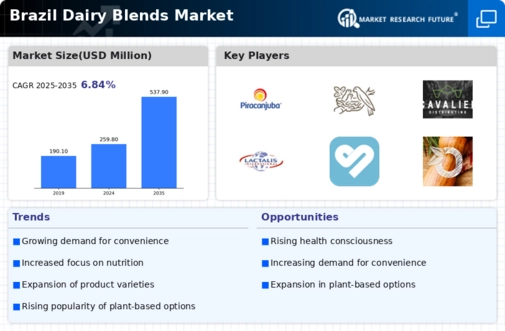Health and Wellness Trends
The dairy blends market in Brazil is significantly influenced by prevailing health and wellness trends, which shape consumer purchasing decisions. As individuals increasingly prioritize their health, there is a marked shift towards products that promote well-being, such as those enriched with probiotics and functional ingredients. This trend is evident in the rising popularity of dairy blends that offer digestive health benefits and immune support. Market analysis indicates that products positioned as health-oriented are expected to capture a larger share of the dairy blends market, potentially reaching a valuation of $1 billion by 2027. The dairy blends market must therefore innovate and adapt to these trends, ensuring that offerings resonate with health-conscious consumers.
Innovative Flavor Profiles
The dairy blends market in Brazil is characterized by the introduction of innovative flavor profiles that cater to diverse consumer tastes. Manufacturers are increasingly experimenting with unique combinations of flavors, such as tropical fruits and spices, to differentiate their products in a competitive landscape. This trend is particularly appealing to younger consumers who seek novel and exciting taste experiences. As a result, the dairy blends market is likely to see a rise in product launches featuring these innovative flavors, which could potentially attract a broader audience. Market data suggests that flavored dairy products account for nearly 40% of total dairy sales, indicating a strong consumer preference for variety and creativity in product offerings.
Expansion of Retail Channels
The dairy blends market in Brazil is witnessing a significant expansion of retail channels, which plays a crucial role in enhancing product accessibility. Traditional supermarkets, convenience stores, and online platforms are increasingly stocking a diverse range of dairy blend products. This expansion is particularly important as it allows consumers to easily access various options, including organic and specialty blends. Recent statistics indicate that online sales of dairy products have surged, with e-commerce accounting for approximately 15% of total dairy sales in Brazil. This shift in purchasing behavior suggests that the dairy blends market must adapt its distribution strategies to meet evolving consumer preferences, ensuring that products are readily available across multiple platforms.
Rising Demand for Nutritional Products
The dairy blends market in Brazil experiences a notable increase in demand for nutritional products, driven by a growing awareness of health and wellness among consumers. This trend is reflected in the rising consumption of dairy blends that offer enhanced nutritional profiles, such as fortified vitamins and minerals. According to recent data, the market for dairy blends is projected to grow at a CAGR of approximately 6.5% over the next five years. This growth is likely fueled by the increasing preference for products that cater to specific dietary needs, including lactose intolerance and protein enrichment. As consumers become more health-conscious, the dairy blends market is expected to adapt by introducing innovative formulations that align with these preferences, thereby expanding its consumer base and market share.
Increased Focus on Clean Label Products
The dairy blends market in Brazil is experiencing a heightened focus on clean label products, reflecting consumer demand for transparency and simplicity in food ingredients. As consumers become more discerning about what they consume, there is a growing preference for dairy blends that contain minimal additives and preservatives. This trend is supported by research indicating that approximately 70% of Brazilian consumers are willing to pay a premium for products that are perceived as natural and free from artificial ingredients. Consequently, the dairy blends market is likely to respond by reformulating existing products and developing new offerings that align with clean label principles, thereby enhancing consumer trust and loyalty.





















Leave a Comment